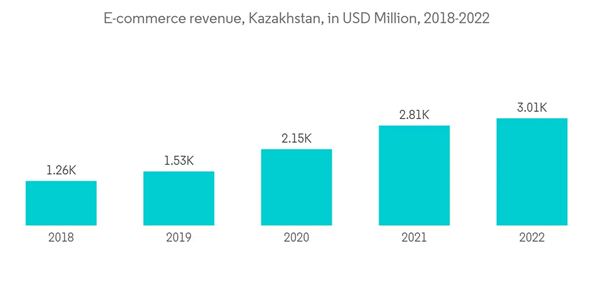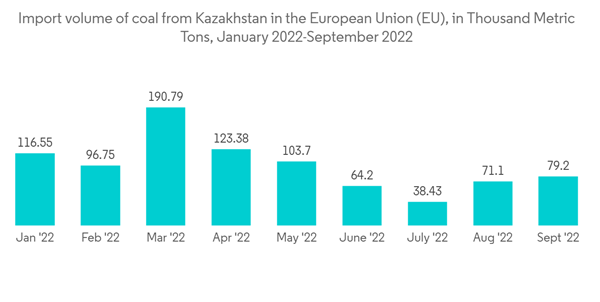The Kazakhstan Freight and Logistics Market size is estimated at USD 11.36 billion in 2024, and is expected to reach USD 14.80 billion by 2029, growing at a CAGR of 5.44% during the forecast period (2024-2029).
The market is driven by the shift of companies and routes from Russian territories to Kazakhstan's territories. Furthermore, the market is propelled by the growth in e-commerce and cross-border rail freight.
With the advancement of new technologies, the variety of products available for purchase online has grown significantly. According to the analytical website Ranking.kz, phones were expected to account for nearly one-fifth of total online retailing volume in 2021. Household appliances, cosmetics, computers, car parts, and construction materials are the next most popular items purchased online. Increased broadband internet coverage has also boosted online sales. According to Ranking.kz, there were more than 17 million cellular subscribers with internet access in April 2022 and 2.8 million registered fixed internet subscribers.
Rail transports the majority of transit and export-import cargoes, accounting for 52.2% of total freight turnover. Kazakhstan's geographical location qualifies it to serve as a transcontinental and transit link between Europe and Asia. Uzbekistan (45%), Kyrgyzstan (20%), Turkmenistan (6%), Tajikistan (9%), Afghanistan (5%), Russia (5.6%), and China (4.5%) are the top transit cargo destinations. Rail transport is crucial in the Euro-Asian Transport Links (EATL) and intermodal services sectors. The majority of rail freight (80%) consists of bulk commodity shipments such as oil, ferrous metals, metal scrap, coal, and grain. The Trans-Caspian International Transport Route (TITR), also known as the Middle Corridor, is one of the few viable options for rail freight transport between China and Europe. The majority of rail freight consists of bulk commodity shipments such as oil, ferrous metals, metal scrap, coal, and grain.
Long-distance trade in and across Central Asia has been unappealing for years due to a lack of effective trade agreements and changing national trade laws, which increased rail transport costs and unpredictability, as well as poor service coordination and time-consuming border crossings. Despite these obstacles, the number of express container trains traversing Central Asia increased from 17 in 2011 to more than 15,000 by 2021. This was accomplished through political will, regional cooperation, and rail reform. Rail transport has also thrived within the region, facilitating trade flows between the People's Republic of China and Central Asia while also contributing to dialogue and transboundary cooperation. This impressive growth can be attributed to simplified processes such as single window and single stop operations, as well as reduced border inspections.
This product will be delivered within 2 business days.
The market is driven by the shift of companies and routes from Russian territories to Kazakhstan's territories. Furthermore, the market is propelled by the growth in e-commerce and cross-border rail freight.
Key Highlights
- The revenue generated by the logistics sector is almost evenly distributed across the country's regions. When we compare this distribution to the spread of retail trade and e-commerce values, we see significant gaps in the regional structure, with Almaty, Nursultan, and Atyrau dominating the market. In recent years, Kazakhstan's freight volume has increased. Freight transportation by all modes of transport (excluding pipelines) reached 4.2 billion tons in 2021, owing to increased e-commerce and better utilization of the country's transit potential. Total transportation revenue (excluding pipelines) reached KZT 1.4 trillion (USD 3.25 billion), with cargo transportation accounting for 78%.
- The consequences of military actions in Ukraine disrupted the entire region's logistics chains: sanctions imposed on Russia and Belarus, suspension of business operations in Russia by several large logistics operators, including Maersk, DSV, and DB Schenker, and the blocking of railway and sea communications - all of this resulted in the blocking of the first and second of the listed routes. Switching cargo shipments to new routes necessitates additional time and investment in increased transport capacity as well as additional CAPEX on vehicles. It has the potential to increase transportation and warehousing costs, burdening producers and importers and reflecting the shelf price of goods. However, price inflation is only one aspect of the issue.
- The demand for warehousing facilities will continue to rise in the short and medium term due to organic factors such as the expanding e-commerce market and the current market situation of companies' cash cycles lengthening. An additional factor supporting the attractiveness of the Kazakh logistics sector will be the anticipated relocation of some businesses from Russia to Kazakhstan. Some of these companies are expected to import non-sanctioned goods into Kazakhstan and then export them to Russia. Furthermore, the exit of large consumer companies from the Russian market opens the door for various intermediaries to purchase the same products in other markets and import them from third countries to meet the demand of Russian consumers.
- Modern geopolitical realities alter Eurasia's logistics map and cargo flow direction. Central Asian countries have already begun using Azerbaijan's transit potential to gain access to global markets. Azerbaijan is being chosen as a transit route by large cargo owners and logistics companies from the aforementioned countries. Freight from Kazakhstan is transported via two routes: the Caspian Sea and the Samur-Yalama border crossing. Rail freight transport between Azerbaijan and Kazakhstan totaled 950,000 tons (an increase of eight times) from January to October 2022, with transit traffic accounting for 96%, according to ADY Express LLC, a subsidiary of Azerbaijan Railways CJSC. These volumes are expected to grow further. Legal and diplomatic efforts are being made to establish a joint venture through the railway administrations of Azerbaijan, Georgia, and Kazakhstan.
Kazakhstan Logistics Market Trends
Kazakhstan Freight & Logistics Market Trends
The digital economy is becoming a new reality in Kazakhstan, with online purchases and payments by card or smartphone becoming part of people's daily routines. Online commerce is gaining traction, with online retail sales expected to reach 482 billion tenges (USD 1 billion) by 2021. Almaty, Kazakhstan's former capital and largest city, leads all other cities in terms of online retail sales volume, with KZT 272.8 billion (USD 607.4 million), or 56.6%. Nur-Sultan comes in second with KZT 49.2 billion (USD 109.5 million), followed by Shymkent with KZT 29.5 billion.With the advancement of new technologies, the variety of products available for purchase online has grown significantly. According to the analytical website Ranking.kz, phones were expected to account for nearly one-fifth of total online retailing volume in 2021. Household appliances, cosmetics, computers, car parts, and construction materials are the next most popular items purchased online. Increased broadband internet coverage has also boosted online sales. According to Ranking.kz, there were more than 17 million cellular subscribers with internet access in April 2022 and 2.8 million registered fixed internet subscribers.
Increase in Cross-border Sea Freight Driving the Market
Due to increased demand for rail transport, China and Kazakhstan are building a third railway on their border, another sign of growing connectivity between the two neighbors that could help boost trade between China and the broader Central Asian region and beyond. According to Chinese experts, the construction of the Central Asian railway network will not only help boost China-Central Asia cooperation and local economies but will also add resilience to China-Europe trade links via the cross-continental rail link. The opening of the new route could alleviate the burden on road transport while meeting the growing demand for trade between China and Europe and China and Central Asia.Rail transports the majority of transit and export-import cargoes, accounting for 52.2% of total freight turnover. Kazakhstan's geographical location qualifies it to serve as a transcontinental and transit link between Europe and Asia. Uzbekistan (45%), Kyrgyzstan (20%), Turkmenistan (6%), Tajikistan (9%), Afghanistan (5%), Russia (5.6%), and China (4.5%) are the top transit cargo destinations. Rail transport is crucial in the Euro-Asian Transport Links (EATL) and intermodal services sectors. The majority of rail freight (80%) consists of bulk commodity shipments such as oil, ferrous metals, metal scrap, coal, and grain. The Trans-Caspian International Transport Route (TITR), also known as the Middle Corridor, is one of the few viable options for rail freight transport between China and Europe. The majority of rail freight consists of bulk commodity shipments such as oil, ferrous metals, metal scrap, coal, and grain.
Long-distance trade in and across Central Asia has been unappealing for years due to a lack of effective trade agreements and changing national trade laws, which increased rail transport costs and unpredictability, as well as poor service coordination and time-consuming border crossings. Despite these obstacles, the number of express container trains traversing Central Asia increased from 17 in 2011 to more than 15,000 by 2021. This was accomplished through political will, regional cooperation, and rail reform. Rail transport has also thrived within the region, facilitating trade flows between the People's Republic of China and Central Asia while also contributing to dialogue and transboundary cooperation. This impressive growth can be attributed to simplified processes such as single window and single stop operations, as well as reduced border inspections.
Kazakhstan Logistics Industry Overview
The Kazakhstan freight and logistics market is fragmented, with the presence of both international and local players. The market has a large number of players like KTZ - Freight Transportation JSC, Panalpina (DSV), Agility Logistics, CJ Logistics, Rhenus, etc. The increased investment in the country's infrastructure and railways creates an opportunity for companies to invest in the market. The local and regional players hold a good share of the market, but increased opportunities create ways for international players as well.Additional Benefits:
- The market estimate (ME) sheet in Excel format
- 3 months of analyst support
This product will be delivered within 2 business days.
Table of Contents
1 INTRODUCTION
2 RESEARCH METHODOLOGY
4 MARKET INSIGHTS DYNAMICS
5 MARKET SEGMENTATION
6 COMPETITIVE LANDSCAPE
8 APPENDIX
Companies Mentioned (Partial List)
A selection of companies mentioned in this report includes, but is not limited to:
- KAZTRANSGAZ AO
- KTZ - Freight Transportation JSC
- Air Astana
- Intergas Central Asia
- Panalpina
- SCAT
- Zhezkazgan Air
- Almaty Consolidation Center
- Agility
- CEVA Logistics
- Rhenus
- DHL
- DSV
- CJ Logistics
- GAC
- UPS*
Methodology

LOADING...










